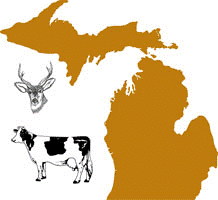Wildlife Disease and Zoonotics
Date of this Version
5-2001
Abstract
Objective—To determine whether Mycobacterium bovis can be transmitted from experimentally infected deer to uninfected in-contact deer.
Animals—Twenty-three 6-month-old white-tailed deer.
Procedure—On day 0, M bovis (2 X 108 colony-forming units) was administered by intratonsillar instillation to 8 deer; 3 control deer received saline (0.9% NaCl) solution. Eight in-contact deer were comingled with inoculated deer from day 21. On day 120, inoculated deer were euthanatized and necropsied. On day 180, 4 in-contact deer were euthanatized, and 4 new incontact deer were introduced. On day 360, all in-contact deer were euthanatized. Rectal, oral, and nasal swab specimens and samples of hay, pelleted feed, water, and feces were collected for bacteriologic culture. Tissue specimens were also collected at necropsy for bacteriologic culture and histologic analysis.
Results—On day 90, inoculated and in-contact deer developed delayed-type hypersensitivity (DTH) reactions to purified protein derivative of M bovis. Similarly, new in-contact deer developed DTH reactions by 100 days of contact with original in-contact deer. Tuberculous lesions in in-contact deer were most commonly detected in lungs and tracheobronchial and medial retropharyngeal lymph nodes. Mycobacterium bovis was isolated from nasal secretions and saliva from inoculated and in-contact deer, urine and feces from in-contact deer, and hay and pelleted feed.
Conclusions and Clinical Relevance—Mycobacterium bovis is efficiently transmitted from experimentally infected deer to uninfected in-contact deer through nasal secretions, saliva, or contaminated feed. Wildlife management practices that result in unnatural gatherings of deer may enhance both direct and indirect transmission of M bovis.



Comments
Published in AJVR, Vol 62, No. 5, May 2001.